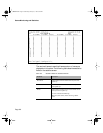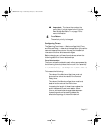
Advanced Management
Page 7-2
Advanced Management
Spanning Tree
Protocol
The Spanning Tree Protocol (STP) is a part of the IEEE 802.1d
bridge specification. It provides fault tolerance on a network
by detecting potential “bridged loops” and then removing them
by blocking the appropriate ports to other switches.
For example, in a large network with multiple paths, there is a
possibility that the same message will get broadcast all over the
network through multiple paths, resulting in a great amount of
extraneous network traffic, and possibly, network downtime.
This “closed path” or “bridged loop” among the networks could
be damaging because it could start an unending packet-passing
process.
With the Spanning Tree Protocol applied to the network, a path
between every pair of accessible nodes on the network is
mapped, ensuring that there are no loops in all of the network
paths.
∆ Note: To explain STP more effectively, the
IntraSwitch is defined as a bridge in this
chapter.
How it Works The Spanning Tree Protocol requires the following:
❏ Communication between all the bridges on the
network.
❏ One bridge to start as a master, or Root Bridge.
The communication between the bridges is carried out using
Bridge Protocol Data Units (BPDUs), which are transmitted in
packets with a known multicast address.
∆ Note: BPDU packets provide information to
the Spanning Tree bridges about the configu-
ration of the Spanning Tree network.
6216M Book Page 2 Wednesday, January 27, 1999 5:26 PM


















